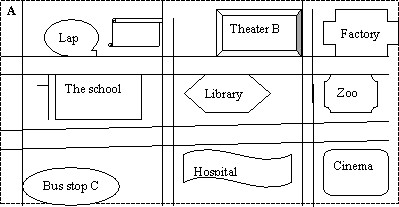教学目标
1.知识目标
(1) New words and phrases:
place, twenty-first, bank, theatre, book shop, toilet, museum, front, in front of, left ,right, side, on the left/right side, all the same, need, ask for, along, road, turn, turning, metre(meter), kilometer(kilometre), had better(do), coin, keep, as, moment, tell, street, next to, around
(2)日常交际用语:
Excuse me. Where’s…? Where’s the nearest hospital, please?
It’s next to …/in front of …/outside…/on the left/right side.
Thank you all the same.
You’d (had)better catch a bus.
Which bus do I take?
Go down this street.
(3)语法项目:表示需要:He needs some help.
询问方向:Where is the nearest hospital, please?
指点方向:Go along this road .it ‘s only 100 meters along on the left.
(4)语音:/ei/ a ay /ai/i ie y / Ri/oi oy
2.能力目标:
(1)使学生掌握英语的问路和指点方向的交际用语并能够在教师创设的情景中灵活运用。
(2)使学生能够读懂课文并能回答课后的问题,按照课文内容表演游戏。
(3)使学生掌握相关表示方向的介词短语,并能根据情景做口头和笔头练习。
(4)使学生能听懂与课文难度相当的文章,并能迅速对听力材料中的相关地点和方向路线做出判断。
3.德育目标:
通过教学让学生注意在日常生活中注意礼貌用语,乐于帮助别人。
通过学习,让学生感受到在生活中受人帮助的欣慰和帮助别人的兴奋之情,培养学生乐于助人的品质。
教学重点和难点:
询问方向(asking for directions)指点方向(Giving direction)是本单元的重点和难点。
教学建议
教材分析
本单元的主要教学内容是问路,从第一课简单的介绍某地在何处。到第二课如何问路和指路。到第四课的扩展练习。问路的相关用语由易到难,由简单到复杂贯穿始终。教师应在教学过程循序渐进,注意打好基础。本单元中第二十三课中还有一个小的游戏,该游戏主要是训练学生阅读理解能力,同时也能活跃课堂气氛,使学生会在快乐中学习。
关于日常交际用语分析(询问方向和指点方向)
问路一般包括四个方面的内容:(1)引起话题:Excuse me… (2) 询问路在何方:How can I get to …? (3)指路:Walk along / down… (4) 致谢:Thank you.
Excuse me, (but…) 通常用于以下几种情景:
(1)引起别人注意。(2)请求让路、躲开时。(3)向人问路或打听消息时。(4)在席间或聚会上等离开一会儿时。(5)谈话间或会间突然打喷嚏、咳嗽时。
询问方向的表达法:
在向别人打听情况、征询意见时,常用Excuse me;在向别人提出请求时,常用Could you…? 而不用Can you…? 更显得礼貌。
(1)Excuse me,where’s the bus station?请问车站在哪?
(2)Excuse me,which is the way to the bus station?请问,哪一条是去车站的路?
(3)Excuse me,can you tell me the way to the bus station?请问,你能告诉我车站的路吗?
(4)Excuse me, how can I get to the bus station?请问,我如何能到达车站?
(5)Excuse me, is there a bus station near here?请问附近有车站吗?
指点方向的表达法:
如果别人向你问路,你熟悉这条路,你又该如何帮助别人呢?下面是几种指点方问的表达法:
(1)Go along this street. 或Walk along this street. 沿这条街道走。
(2)Take the (second ) turning on the left / right.第(2)个十字路口左(右)转。
(3)It’s about (four) kilometers away form here.离这大约(4)公里远。
(4)The bus station is along that road on the right.车站是沿着那条路的右边。
(5)It’s next to the police station. 它与警察局相邻。
(6)It’s about ten kilometers away. 大约10公里远。
(7)It’s quite far / near from here. 离这儿相当远/近。
(8)It about (five) minutes’ walk form here.从这儿步行大约5分钟。
注:别人向你问路,即使你不知道,你也要说:
I’m sorry I don’t know. 对方应回答道:Thank you all the same.
表示需要:need +名词或need + to + v. ……
(1)He needs a number 2 bus. 他需乘2路车。
(2)You need to take a taxi. 你需要乘出租车。
关于口语的教学建议
本单元的教学活动主要是围绕问路这一主题展开。而这个主题可为口语练习提供丰富的素材和场景,所以口语教学是本单元的重点。
(1)第20课是简单的询问方向。要求学生在熟练掌握表示方向的介词用法的基础上,利用图片和媒体资料创设情景,进行口语练习。例如:教师在黑板上画出一张简易地图,用各种的形状的硬纸片上面写上不同的地点,分别贴在公路两侧。如图所示:
然后让学生就内容进行对话练习。教师可以用顶针的手法连续进行快速提问,以锻炼学生的反应能力和句型熟练程度如:Where is the school? It is next to the hospital. Where is the hospital? It is in front of the factory. Where is the factory? It is behind the hotel. 然后,教师可以重新调整图片的位置,让学生再进行练习。
(2)在22课的对话教学中,教师在教学过程中可以先让预习好的学生做表演,在表演的过程中,边演边总结问路的三种情况:第一种情况是指明路线。第二种情况是乘车的回答。第三种情况是不知路线的答复。然后,再请学生进行替换词练习。教师可以设计一个问路的情景,将学生分成三个大组,每个大组选择上述一种情况。每个大组又以两人为单位分成几个小组,进行练习。每个大组选出一个练习情况好的小组代表本组进行角色表演。情景设计如下:Mike moves into new house. One day, her friend Lily want to see her. But she doesn’t know the way. What can she do? At this moment, a boy comes up to her. How does Mary ask the way?
(3)在24 课的口语练习中,学生可进一步加大练习的综合性,使这个练习更贴近实际生活,给学生更多的发挥的空间。教师只提供地图和要去的地点,要学生自己设计情景,编写对话,教师出示问题where is B? How can I get to B from A? Where is C? How to get to C from B? How can I get to A from C?
下面是学生设计情景和对话:
Mary is going to the theater to see a concert. But she doesn’t know the way. So she ask a policeman.
Mary: Excuse me! I want to go to the theater. Where is the theater?
Police man: It is next to the factory, in front of the library.
Mary: Can you tell me the way to the theater?
Policeman: Walk along this road; turn left at the first turning. Go straight the street. The theater is on the left of the road. It is about three miles from here.
Mary: Thank you.
When the concert is over, Mary is tired; she wants to go home by bus .So she asks the police man again how to get to the bus station. But when she gets to bus station, it is too late, and there are no buses in it .so she has to ask the way three times to get home.(问路具体内容模仿本课第二十二课对话内容)
总之,教师在安排口语练习时应逐步的从简单到复杂,由单项到综合,由机械训练到学生自由的表演。
有关听力的教学建议
本单元的听力教学难点在于如何听懂指路人的指令,从而找到要去的地点。
教师可以在学生听第一遍时,先找出出发点和目的地。然后,看一下地图,迅速判断一下应该怎样走,并要求学生用英语讲出自己设计的路线。然后在听第二遍后,再按照材料的内容,在地图上画出相应的路线,并验证与自己设计路线是否一致,这样有助于分解听力难度,帮助学生排除听力障碍。
教师可以组织一个小游戏以训练学生听清有关指令,在教室中摆几个路牌如the Beijing zoo. the Beijing university 等。两个学生分别向对方讲述所要去的路线。看那个学生先找到要去的地点。教师可以拿表计时,当裁判。教师对先到达目标的同学进行奖励。(注意学生需要按照对方所提供的路线到达目标)要求学生必需先听完指令再开始行动。
有关单词教学建议
本单元第一课表示地点和方向的单词比较多。建议教师在设计练习时把表示方向的


